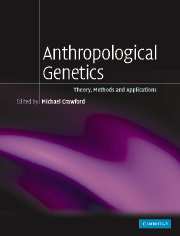Book contents
- Frontmatter
- Contents
- List of Contributors
- Preface
- Chapter 1 Foundations of Anthropological Genetics
- Part 1 Theory
- Part 2 Methods
- Chapter 4 The Importance of Field Research in Anthropological Genetics: Methods, Experiences and Results
- Chapter 5 The Confluence of Anthropological Genetics and Anthropological Demography
- Chapter 6 Molecular Markers in Anthropological Genetic Studies
- Chapter 7 The Use of Quantitative Traits in Anthropological Genetic Studies of Population Structure and History
- Chapter 8 Ancient DNA and its Application to the Reconstruction of Human Evolution and History
- Part 3 General Applications
- Part 4 Part IV The Human Diaspora
- Index
- References
Chapter 8 - Ancient DNA and its Application to the Reconstruction of Human Evolution and History
Published online by Cambridge University Press: 05 June 2012
- Frontmatter
- Contents
- List of Contributors
- Preface
- Chapter 1 Foundations of Anthropological Genetics
- Part 1 Theory
- Part 2 Methods
- Chapter 4 The Importance of Field Research in Anthropological Genetics: Methods, Experiences and Results
- Chapter 5 The Confluence of Anthropological Genetics and Anthropological Demography
- Chapter 6 Molecular Markers in Anthropological Genetic Studies
- Chapter 7 The Use of Quantitative Traits in Anthropological Genetic Studies of Population Structure and History
- Chapter 8 Ancient DNA and its Application to the Reconstruction of Human Evolution and History
- Part 3 General Applications
- Part 4 Part IV The Human Diaspora
- Index
- References
Summary
Introduction
The use of ancient nucleic acids to infer population history and phylogeny is now entering its third decade, with the initial demonstration of the possibility and utility of the approach pioneered by Higuchi et al. (1984) on museum specimens of the extinct quagga, and by Pääbo (1985) on preserved soft tissue from Egyptian mummies. Now uniformly termed ancient DNA (aDNA) studies, the approach has exploded in the past decade to encompass studies of modern human origins, regional history and dynamics of prehistoric human populations, as well as phylogenetic studies of nonhuman organisms. A full review of this vast and rapidly growing literature is beyond the scope of this chapter, and interested readers are directed to several excellent and recent reviews of the field from a variety of disciplinary perspectives (e.g. Wayne et al., 1999; O'Rourke et al., 2000a; Hofreiter et al., 2001a; Kaestle and Horsburgh, 2002, Pääbo et al., 2004, Cipollaro et al., 2005).
The study of contemporary patterns of human genetic variation has proven a powerful approach to inferring human population history and evolution, although such approaches are bound by assumptions of evolutionary rates in the markers under study, effective population sizes over time, rates of population movement, levels of admixture, etc. The use of aDNA analyses in conjunction with such modern genetic studies affords a temporal perspective on human genetic variation that is, to some degree, independent of model assumptions.
- Type
- Chapter
- Information
- Anthropological GeneticsTheory, Methods and Applications, pp. 210 - 232Publisher: Cambridge University PressPrint publication year: 2006
References
- 1
- Cited by



